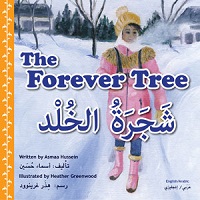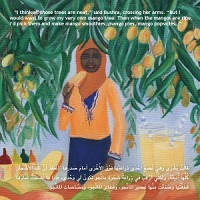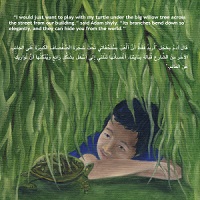| ________________
CM . . .
. Volume XXIII Number 11. . . .November 18, 2016

 |
The Forever Tree.
Asmaa Hussein. Illustrated by Heather Greenwood. Translated into Arabic by Mohamed Osama Kamal.
London, ON: Compass Books, 2015.
24 pp., stapled pbk., $9.99.
ISBN 978-0-9868481-5-5.
Kindergarten-grade 3 / Ages 5-8.
Review by Dave Jenkinson.
*1/2 /4
|
| |
|

excerpt:
“I miss the trees, too,” replied Ms. Kassem. “I have a wonderful childhood memory from Palestine of my family having summer picnics under a beautiful old olive tree at my grandfather’s farm. Olive trees are my favourite trees. What about all of you?”
The Forever Tree begins on a cold winter day with its young protagonist, Zainab, walking to school. The story features the students and teacher of a culturally diverse classroom taking the time to discuss their favourite types of trees. Each child in the classroom shares her/his experiences and fondness for different types of trees they are familiar with all over the world. The children and their teacher initially come to this activity when one child remarks, “I wish it was summer so we could play outside....I miss seeing leaves on all the trees.”
 The picture book also features English alongside Arabic text which can benefit Arabic students and families whose first language is not English. The author and illustrator, Asmaa Hussein and Heather Greenwood, mean well in their inclusive depictions of children from different cultures growing up and going to school together, but the dialogue is very rigid, unrealistic, and, overall, the book lacks an engaging plot. It is also unclear whether the illustrations are supposed to appear somewhat grainy and blurred, or if this is due to the printing of the original artwork. The picture book also features English alongside Arabic text which can benefit Arabic students and families whose first language is not English. The author and illustrator, Asmaa Hussein and Heather Greenwood, mean well in their inclusive depictions of children from different cultures growing up and going to school together, but the dialogue is very rigid, unrealistic, and, overall, the book lacks an engaging plot. It is also unclear whether the illustrations are supposed to appear somewhat grainy and blurred, or if this is due to the printing of the original artwork.
 When it comes to Zainab’s turn to describe her favourite tree, she describes her forever tree in very religious terms. Her “tree” is very much linked to her Muslim faith, and the heavily religious text at the end, which requires a Glossary on the last page for translation, makes the book unsuitable for public schools and libraries. The Arabic words Zainab uses translate to phrases in the glossary such as “All praise is due to God” and “There is no deity worthy of worship except God”. For readers with no knowledge of Islam The Forever Tree appears to be a story of salvation in order to reach a tree which only exists in “Jannah”/ “Paradise”. It is also unrealistic that the non-Muslim children would all abandon their love for their favourite trees to exclaim things like: “Who needs cherry blossoms when you can have a forever tree?”. When it comes to Zainab’s turn to describe her favourite tree, she describes her forever tree in very religious terms. Her “tree” is very much linked to her Muslim faith, and the heavily religious text at the end, which requires a Glossary on the last page for translation, makes the book unsuitable for public schools and libraries. The Arabic words Zainab uses translate to phrases in the glossary such as “All praise is due to God” and “There is no deity worthy of worship except God”. For readers with no knowledge of Islam The Forever Tree appears to be a story of salvation in order to reach a tree which only exists in “Jannah”/ “Paradise”. It is also unrealistic that the non-Muslim children would all abandon their love for their favourite trees to exclaim things like: “Who needs cherry blossoms when you can have a forever tree?”.
Not Recommended.
Dave Jenkinson, CM’s editor, lives in Winnipeg, MB.

To comment
on this title or this review, send mail to cm@umanitoba.ca.
Copyright © the Manitoba Library Association. Reproduction for personal
use is permitted only if this copyright notice is maintained. Any
other reproduction is prohibited without permission.
Next Review | Table of Contents For This Issue - November 18, 2016
CM Home | Back Issues
| Search
| CM Archive
| Profiles Archive
|

 The picture book also features English alongside Arabic text which can benefit Arabic students and families whose first language is not English. The author and illustrator, Asmaa Hussein and Heather Greenwood, mean well in their inclusive depictions of children from different cultures growing up and going to school together, but the dialogue is very rigid, unrealistic, and, overall, the book lacks an engaging plot. It is also unclear whether the illustrations are supposed to appear somewhat grainy and blurred, or if this is due to the printing of the original artwork.
The picture book also features English alongside Arabic text which can benefit Arabic students and families whose first language is not English. The author and illustrator, Asmaa Hussein and Heather Greenwood, mean well in their inclusive depictions of children from different cultures growing up and going to school together, but the dialogue is very rigid, unrealistic, and, overall, the book lacks an engaging plot. It is also unclear whether the illustrations are supposed to appear somewhat grainy and blurred, or if this is due to the printing of the original artwork. When it comes to Zainab’s turn to describe her favourite tree, she describes her forever tree in very religious terms. Her “tree” is very much linked to her Muslim faith, and the heavily religious text at the end, which requires a Glossary on the last page for translation, makes the book unsuitable for public schools and libraries. The Arabic words Zainab uses translate to phrases in the glossary such as “All praise is due to God” and “There is no deity worthy of worship except God”. For readers with no knowledge of Islam The Forever Tree appears to be a story of salvation in order to reach a tree which only exists in “Jannah”/ “Paradise”. It is also unrealistic that the non-Muslim children would all abandon their love for their favourite trees to exclaim things like: “Who needs cherry blossoms when you can have a forever tree?”.
When it comes to Zainab’s turn to describe her favourite tree, she describes her forever tree in very religious terms. Her “tree” is very much linked to her Muslim faith, and the heavily religious text at the end, which requires a Glossary on the last page for translation, makes the book unsuitable for public schools and libraries. The Arabic words Zainab uses translate to phrases in the glossary such as “All praise is due to God” and “There is no deity worthy of worship except God”. For readers with no knowledge of Islam The Forever Tree appears to be a story of salvation in order to reach a tree which only exists in “Jannah”/ “Paradise”. It is also unrealistic that the non-Muslim children would all abandon their love for their favourite trees to exclaim things like: “Who needs cherry blossoms when you can have a forever tree?”.